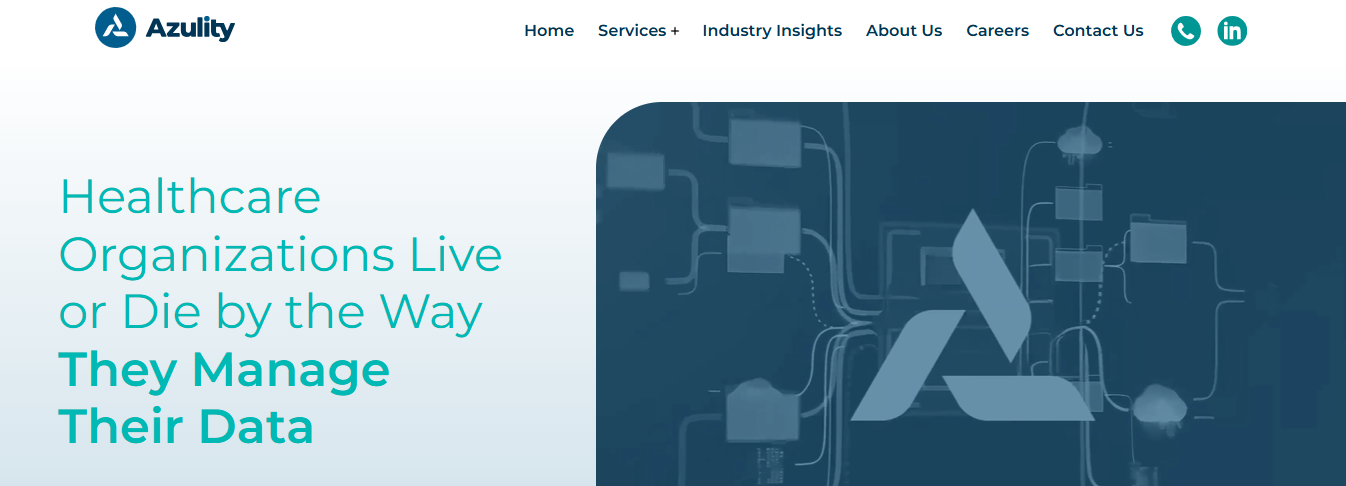Provider credentialing and privileging is an essential process for healthcare organizations. It helps ensure practitioners have the appropriate qualifications and expertise to deliver quality care to patients.
However, as healthcare’s regulatory environment becomes more complex, organizations struggle to keep up. If you’re facing similar challenges, you’re not alone. This guide will offer valuable insights to help you streamline your credentialing and privileging processes and allow your organization with innovative data management.
Azulity’s provider credentialing services can help you achieve your objectives and return to what you do best: caring for patients. Our solutions will help you improve your organization’s credentialing and privileging processes so you can focus on delivering quality care to patients.
What is Credentialing?

Credentialing is an essential process that enhances the reputation of medical professionals. It formally investigates a medical professional’s qualifications, background, training, and experience. Credentialing aims to ensure that patients receive care from qualified and competent professionals.
Credentialing is also helpful for medical billing systems. With proper credentialing, reimbursements can be issued promptly without any problems. Credentialing seeks to validate a medical degree and ensure that patients only obtain treatment from professionals who are skilled, qualified, educated, and willing to practice.
What Is Provider Credentialing? – Definition
Provider credentialing is the process by which medical organizations and Insurance companies verify the credentials of healthcare providers to ensure they have the required licenses, certifications, and skills to care for patients properly. It is also called physician credentialing, medical credentialing, or doctor credentialing.
How Medical Credentialing Works
Each medical practice should employ a dedicated credentialing person or outsource credentialing services so that the system operates efficiently and healthcare professionals can carry out their duties in a secure environment. The license for practical use is often tested for optimum efficiency after insurance companies test the certificates of the physician or healthcare organization.
1. Verify the Clinic
Verify the clinic, training, and efficiency of the physicians.
2. Provider Eligibility for Healthcare Services
Verify if a healthcare provider fulfills the requirements for hospital work.
3. Set Basic Rules
Set ground rules to deny professional verification following the pre-application process.
4. Create a process to reapply
Establish a procedure for the rejected healthcare worker to re-apply after rejection.
5. Mechanism for rapid credentialing
Have a mechanism for rapid credentialing of emergency personnel and short-term employment staff.
6. Limit providers who don’t follow the Guidelines
Limit individual healthcare workers who do not comply with guidelines or health requirements.
What is Privileging?


Privileging grants authority to qualified healthcare providers to perform specific procedures, such as surgeries, within a healthcare organization. For example, an organization may privilege only the most senior surgeons to conduct complex operations. To be granted privileges, a surgeon must demonstrate that they have the necessary training and experience to perform the procedure before being approved to operate at the facility. Privileging is an ongoing process that involves four basic steps:
- The organization determines the scope of services and procedures it will offer and support.
- Then, they determine the minimum criteria or qualifications required for those services.
- The organization then evaluates whether the applicant meets the requirements.
- Finally, the organization monitors privileges granted to providers to ensure current competency.
Delivering Quality Care with Provider Credentialing and Privileging
Provider credentialing and privileging work together to ensure patients receive quality care from qualified clinicians. Credentialing verifies a provider’s qualifications, while privileging determines what services or procedures a provider can perform at a particular facility. Both processes involve extensive data collection and analysis, which is essential for patient safety.
Related Reading
- CVO Credentialing
- Best Credentialing Software
- Credentialing in Healthcare
- How to Credential a Provider
- How Long Does Credentialing Take
Difference Between Credentialing and Privileging


Credentialing and privileging are two separate processes that often need clarification. Credentialing is the process of obtaining, verifying, and assessing the qualifications of a licensed or certified healthcare practitioner. Privileging, on the other hand, is the process of authorizing a practitioner to provide specific patient care services within their scope of practice. In this case, privileges refer to the particular clinical activities or procedures that a practitioner is allowed to perform, and they are determined based on the practitioner’s training and competence, not solely on their credentials.
Why Credentialing and Privileging Matter
Credentialing and privileging are required before practitioners can provide care at healthcare organizations. Without them, hospitals and other medical facilities face severe legal risks. The processes also help ensure quality patient care. The National Committee for Quality Assurance, the Centers for Medicare and Medicaid Services, and the Joint Commission all have requirements to ensure that medical practitioners are appropriately credentialed and privileged before providing patient care.
What to Include in Credentialing and Privileging Documentation
- A provider will typically need to provide the following information and documentation:
- Educational history and transcripts
- Current medical license
- DEA registration
- Board certification (if applicable)
- Work history
- Evidence of Continual Malpractice Coverage
- Personal immunization records
- Professional and personal references
- CAQH enrollment
- OIG/SAM Exclusion Check
Specific requirements for applying may vary depending on the healthcare facility and the particular role of the provider. Still, as you can see, dozens of documents are required for each provider. Paper can (literally) stack up, and getting all documentation from a provider is tough. Many healthcare organizations are turning to credentialing software that enables them to email a provider with a link to upload all documents securely.
Related Reading
- How Much Does Credentialing Cost
- Types of Credentialing in Healthcare
- Hospital Credentialing Requirements
- Provider Enrollment and Credentialing
- Primary Source Verification Credentialing
Importance of Credentialing and Privileging in Healthcare


Credentialing: The Backbone of Patient Safety
Credentialing verifies a healthcare professional’s qualifications, including their education, training, residency, licenses, certifications, and work history. This thorough assessment helps hospitals, medical groups, and patients determine a provider’s competency to deliver the care they seek.
Credentialing Increases Trust. Verifying the qualifications of hospitals and healthcare agencies assures patients of a healthcare professional’s merit and experience, allowing them to trust their chosen providers.
Prevent Losing Revenues. Credentialing can help prevent medical practices from losing money in lost revenue from delayed or denied reimbursements. To clarify, paying attention to receiving proper credentialing can result in insurance payers failing to reimburse medical practices for their treatments.
Lowers the risk of medical errors. It is estimated that about 98,000 Americans die from medical mistakes every year. This alarming number forces industry leaders to push for better standards of exposure and competency to disciplinary measures against healthcare professionals. Credentialing for healthcare facilities and independent practitioners lowers the risk of medical errors.
Protects You from Lawsuits. Having an accurate and complete record of every practitioner’s credentials will be helpful in litigation. For example, you can save yourself if there is a negligence claim against a healthcare professional in your institution. In short, you can save your facility from a lawsuit by confirming that you verified all of their credentials as required.
You are credentialed with Insurance Networks. The process takes patience and time. First, you have to decide to proceed with the process. Second, you must shortlist the insurance companies you want to work with. Finally, it’s time to take the first step. Knowing that the credentialing procedure may take a few months is essential.
Privileging: The Key to Smoother Operations
Here are several critical reasons for proper privileging management at the executive level:
Reducing Costly Delays
Every day, a provider’s lack of privileges to deliver patient care can cost a healthcare organization thousands of dollars in revenue. Inaccurate or incomplete application information, lagging peer references, and administrative backlogs may result in delays. Providers can request temporary privileges to get reimbursements, but this costs the organization money by duplicating the process and forcing leaders to approve privileges more than once.
Enhancing Clinical Effectiveness and Quality of Care
Credentialing and privileging are essential actions organizations take to improve clinical effectiveness and deliver high-quality patient care. These processes help verify that healthcare providers are qualified, competent, and capable of providing safe and effective care.
Compliance with Regulatory Requirements
Healthcare organizations are legally responsible for verifying that all providers are appropriately credentialed and privileged. They must be able to produce all documentation and approvals for the privileges to simplify information requests during audits and surveys. Proper privileging documentation is also critical to meet the standards of regulatory bodies such as the Centers for Medicare and Medicaid Services (CMS) and the National Committee for Quality Assurance (NCQA).
Mitigating Legal and Financial Risks
Proper privileging helps protect healthcare facilities from negligent credentialing lawsuits, which can result in significant financial and administrative consequences. Such lawsuits can threaten a hospital’s ability to participate in federally funded programs like Medicare and Medicaid.
Supporting Value-Based Care Models
Value-based care models require comprehensive data gathering and quality measure reporting. This necessitates thorough and well-informed credentialing and privileging decisions, which demand deeper communication between board members and credentialing committees.
Safeguarding Patient Safety
Privileging processes are crucial in protecting patient safety by seeing that only qualified and competent practitioners can provide care. This includes ongoing monitoring and reevaluation of providers to maintain high standards of care.
Fostering Board Engagement and Effective Decision-Making
Credentialing and privileging processes require thoughtful discussions and collaboration among board members, including physicians and lay trustees. This engagement helps leaders make well-informed and balanced decisions, contributing to better governance and oversight.
Key To Effective Credentialing and Privileging in Healthcare


Use Azulity: The Credentialing and Privileging Game Changer


You don’t have to go it alone regarding credentialing and privileging in healthcare. Azulity specializes in healthcare master data management and provider credentialing services, bringing proven expertise in implementing healthcare data solutions and credentialing across the US. Our comprehensive platform ensures consistent patient, provider, location, and claims data synchronization across all systems and departments.
Key features include healthcare MDM, provider MDM, reference data management, credentialing, and provider enrollment. We serve healthcare technology leaders—from CIOs and CDOs to VPs of data platforms and credentialing—helping them eliminate the costly problems of fragmented data systems. Book a call to learn more about our healthcare master data management services today!
Data Gathering, Verification, and Documentation
The first step of any credentialing and privileging process is acquiring credentials from the applicants. Every practitioner—independent, contracted, employed, volunteer, or temporary—should be prepared to submit credentials every time they extend the scope of their services or change their employment or practice location.
Additionally, all practitioners should be required to get re-credentialed every two years to maintain their privileges. This includes re-verifying the practitioner’s licenses, credentials, and certifications through primary-source verification.
The organization should also review quality-of-care, peer review, Ongoing Professional Practice Evaluation (OPPE), and performance-improvement information for the previous two years. In addition to submitting qualifications such as education and licensure, applicants must also provide three verified peer-review letters that assess the applicant’s training, professionalism, and competence.
Perpetual documentation is key to good data-acquisition practices for organizations. Whenever new licensures, certifications, or other credentialing requirements are received, they must be retained permanently. These files must be properly secured and kept separate from files maintained by human resources departments—even for providers employed by the hospital or practice. A system should be in place to monitor expiration dates and remind providers of deadlines to renew their credentials and privileges.
Poor documentation can have consequences. If privileges are granted to a practitioner with negative peer-review information and a patient is later harmed, the organization may risk a claim due to negligent credentialing. On the other hand, if the organization receives informal negative feedback from peers—but not in written form—and a practitioner is then denied privileges, the organization risks liability for wrongful denial of privileges.
Assessment and Confirmation of Credentials
The next step is to verify and assess the records and other credentialing documents that have been acquired. During this process, a practitioner’s reported qualifications, such as education or licensure, are confirmed by the original or primary source, preventing hiring individuals who falsely pose as healthcare practitioners.
This process also identifies providers with red flags on their credentialing applications, alerting verifiers to explore their backgrounds further. Peer-review letters should also be carefully reviewed. Any negative information revealed should be flagged for further investigation.
The organization should also conduct background checks to uncover past criminal behavior or medical malpractice payments, adverse actions, or sanctions issued. Background checks may also alert you to potential behavioral issues. Documented background checks demonstrate that an organization has completed due diligence.
We strongly recommend querying the National Practitioners Data Bank (NPDB) upon initial appointment and reappointment. Completing a criminal background check when a provider is initially appointed may reveal information not identified by other database searches and allow the organization to make informed decisions.
Oversight and Recommendations
When all the steps in the credentialing process have been completed, a formal group of stakeholders should review all recommendations. They can grant or deny privileges and permissions to provide services or treatment based on the practitioner’s training, experience, and demonstrated competence. All final decisions should be written to the practitioner, with a copy in the credentialing file.
Book a Call to Learn More About Our Provider Credentialing Services
Credentialing and privileging processes rely heavily on accurate data. Every provider, facility, and location has a unique profile that contains specific details about their education, training, experience, and more. Over the years, these profiles have changed, and they can become outdated or inaccurate without the proper data management practices. Credentialing can begin once a provider’s profile is verified and current.
One of the most effective ways to ensure accuracy and consistency for credentialing and privileging processes is to implement healthcare master data management practices. These processes create a framework for organizing, updating, and maintaining medical data so that all systems and stakeholders can access the most current information. If you’re looking for ways to streamline credentialing and privileging in your organization, consider prioritizing healthcare master data management.
Master Data Management: The Basics
Master data management is the management of an organization’s critical data to provide a single, accurate view to all systems and stakeholders. In healthcare, master data management focuses on improving the accuracy of data related to patients, providers, locations, and other entities involved in care delivery.
Over time, implementing a master data management system creates better data quality, eliminates redundancy, and reduces the time and costs associated with inaccurate or fragmented data. Regarding credentialing and privileging, healthcare master data management improves both processes by ensuring that the information used to decide on a provider’s qualifications is current and complete. This helps organizations mitigate risk and improve patient safety by ensuring that only qualified providers deliver care.
What is Healthcare Credentialing?
Credentialing in healthcare refers to verifying medical professionals’ qualifications to ensure they can provide patient care. This process involves reviewing their education, training, professional experience, and any certifications and licenses to confirm they are current and free of restrictions. Credentialing aims to ensure that providers have the knowledge and skills to deliver patient care safely.
What is Healthcare Privileging?
Privileging goes hand-in-hand with credentialing, but it’s a separate process. While credentialing verifies a provider’s qualifications, privileging determines the specific tasks and responsibilities a provider can perform at a healthcare organization. Privileging is often based on the provider’s area of expertise, and it takes into account their education and training, as well as any clinical experience and performance data specific to the organization. Like credentialing, privileging is essential for patient safety, as it helps ensure that qualified providers perform clinical tasks.
Azulity: The Credentialing and Privileging Game Changer
You don’t have to go it alone regarding credentialing and privileging in healthcare. Azulity specializes in healthcare master data management and provider credentialing services, bringing proven expertise in implementing healthcare data solutions and credentialing across the US. Our comprehensive platform ensures consistent patient, provider, location, and claims data synchronization across all systems and departments.
Key features include healthcare MDM, provider MDM, reference data management, credentialing, and provider enrollment. We serve healthcare technology leaders—from CIOs and CDOs to VPs of data platforms and credentialing—helping them eliminate the costly problems of fragmented data systems. Book a call to learn more about our healthcare master data management services today!